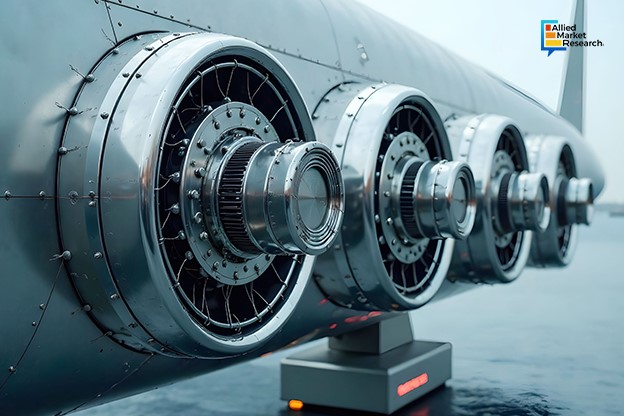Aircraft Propulsion Systems: A Look at the Recent Innovations Transforming the Industry

30 Apr
2025
Key takeaways:
- Introduction
- Technological advancements in the industry
- Product launches in the sector
An aircraft propulsion system is a machine that produces thrust to move the aircraft through the air. It is the most important component of the airplane as it helps create the energy necessary to overcome aerodynamic drag and lift it into flight. Typically, an aircraft propulsion system includes the engine, propellers, turbofans, and other such equipment to create a mechanical force to power the jet. In the last few years, the shift toward electric mobility has led to the development of hybrid airplanes, which have broadened the scope of the aircraft propulsion system industry. Furthermore, the growing demand for air travel has impacted the sector positively.
Technological advancements in aircraft propulsion systems helping the sector flourish
In the COVID-19 pandemic, almost all major airline manufacturers witnessed a significant decline in their growth rates due to the lockdowns and travel restrictions enacted by governments across the world. To overcome these losses, many companies started investing in R&D projects to design technologies that increase aircraft’s efficiency and minimize their operational costs. The advent of high-bypass turbofans has been one such development that has revolutionized the aircraft propulsion system industry in recent years.
Unlike conventional machines, the air drawn in by these large turbofans flows around the engine core, instead of going through it, thus allowing for efficient propulsion of the aircraft. Due to its high-bypass ratio, the volume of fuel required to power the airplane is much less compared to traditional systems. Also, the optimized airflow configuration associated with these machines reduces the noise generated while the jet is in flight. Due to their advantages, high-bypass turbofans are now widely used in military aircraft to boost engine performance and enhance stealth capabilities.
Along with this, the increased deployment of open rotor engines has enabled commercial aircraft companies to reduce the carbon footprint of their operations drastically. Aviation engineering studies have shown that propulsion systems featuring these innovative machines use 20-25% less fuel compared to conventional solutions, thus reducing the volume of carbon emissions. Over the years, rising awareness regarding environmental sustainability has surged the demand for open rotor engines, thereby accelerating sectoral growth.
Launch of novel products by leading companies opening new investment avenues
Recently, several multinational giants have unveiled innovative aircraft propulsion systems to address the changing dynamics of the sector and strengthen their foothold in the industry. For example, in June 2022, Rolls-Royce, a British multinational aerospace and defense company, announced the development of a turbogenerator technology designed for hybrid-electric aircraft. In addition to its advanced aircraft propulsion systems, this new solution is ideal for eVTOL and fixed-wing commuter aircraft for inter-city flights. The product has been manufactured in collaboration with the German Federal Ministry of Economic Affairs and Climate Change.
In April 2024, ZeroAvia, an aerospace company, introduced a new set of electric and hydrogen aviation components, including electric motors, silicon carbide inverters, high-temperature PEM, and an aviation fuel cell compressor. As per the press release issued by the firm, ZeroAvia has been actively engaging with different aircraft manufacturers to jointly develop cutting-edge propulsion systems using these machines.
Winding up, the aircraft propulsion systems market is expected to witness immense growth in the next few years due to the increasing investments by private companies in R&D projects. Moreover, rising demand for air travel and advent of innovative aerospace technologies are estimated to create lucrative opportunities for the sector in the coming period.
Contact our experts for the latest developments and upcoming trends in the landscape!

Akhilesh Prabhugaonkar
Author's Bio- Akhilesh Prabhugaonkar holds a bachelor’s degree in Electronics Engineering from the reputed Vishwakarma Institute of Technology. He has a special interest in the fields of forensics, world history, international relations and foreign policy, sports, agriculture, astronomy, security, and oceanography. An ardent bibliophile and melophile, Akhilesh loves to write on topics of his interest and various other societal issues. This love for writing made him enter the professional world of content writing and pursue his career in this direction.
Avenue: Entire Library membership of Allied Market Research Reports at your disposal
- Avenue is an innovative subscription-based online report database.
- Avail an online access to the entire library of syndicated reports on more than 2,000 niche industries and company profiles on more than 12,000 firms across 11 domains.
- A cost-effective model tailored for entrepreneurs, investors, and students & researchers at universities.
- Request customizations, suggest new reports, and avail analyst support as per your requirements.
- Get an access to the library of reports at any time from any device and anywhere.
Related Post
-
How are Submarine Cables Transforming Global Connectivity with Enhanced User Experience?
-
Endoscopy Procedures: Transformations in Techniques and Applications
-
AI-Powered Video Analytics: How the Product Actually Works for enterprises
-
Painting Robots: Transforming Precision Coating and Creative Applications
-
Innovations in Pharmacovigilance Systems Advancing Patient Safety
-
Understanding Edge Security: Keeping Data Safe Near the Source
-
Exploring the Use and Advancements of 3D Laser Scanners in Professional Applications
-
Reinforcing Industrial Controls with Smarter Tools and Training








